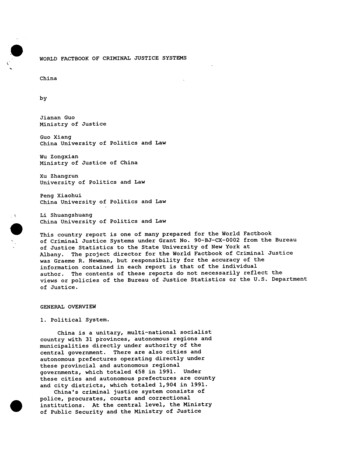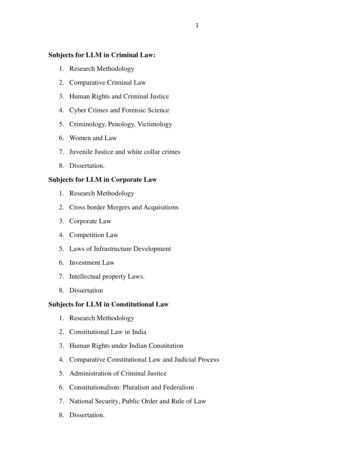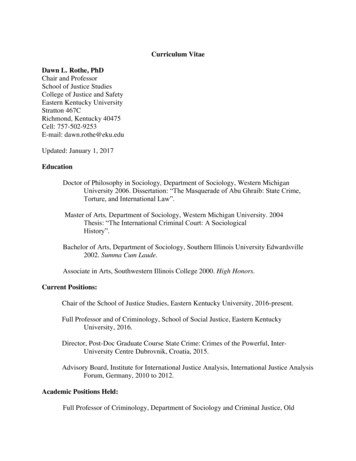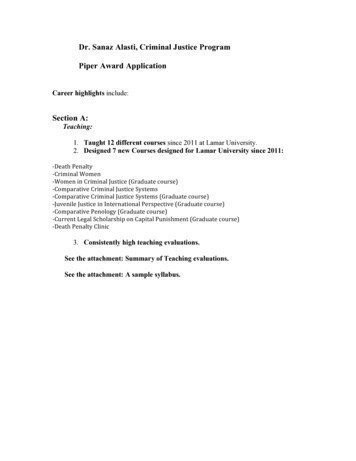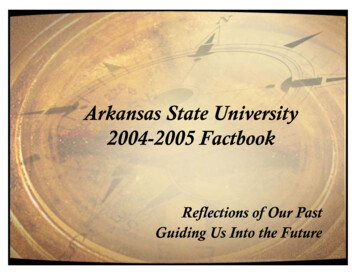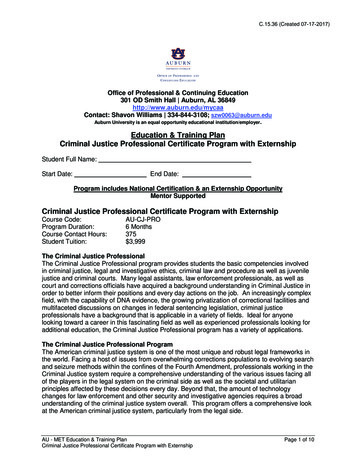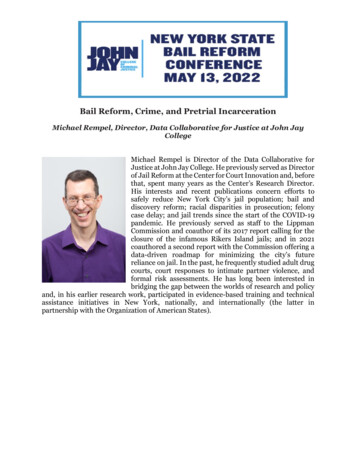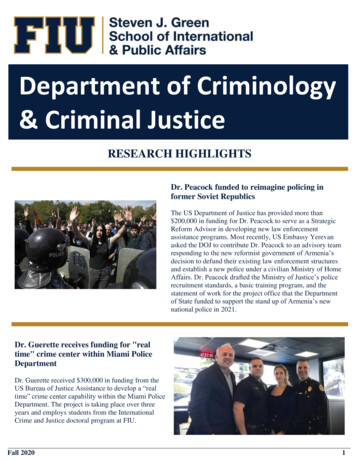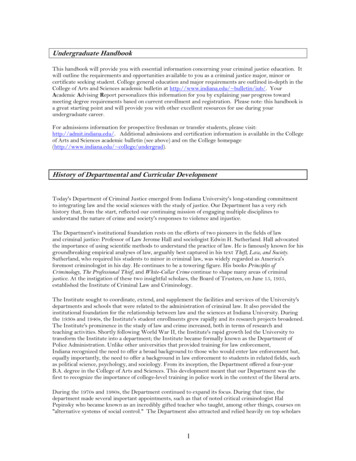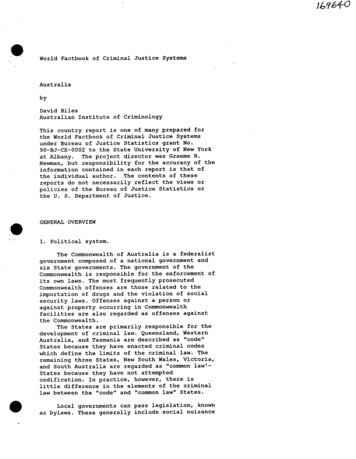
Transcription
World Factbook of CriminalJustice SystemsAustraliabyDavid BilesAustralian Instituteof CriminologyThis country report is one of m a n y prepared forthe World Factbook of Criminal Justice Systemsunder B u r e a u of Justice Statistics grant No.90-BJ-CX-0002 to the State University of New Yorkat Albany.The project director was Graeme R.Newman, but responsibility for the accuracy of theinformation contained in each report is that ofthe individual author.The contents of thesereports do not necessarily reflect the views orpolicies of the Bureau of Justice Statistics orthe U. S. Department of Justice.GENERAL OVERVIEWi. Politicalsystem.The Commonwealth of Australia is a federalistgovernment composed of a national government andsix State governments. The government of theCommonwealth is responsible for the enforcement ofits own laws. The most frequently prosecutedCommonwealth offenses are those related to theimportation of drugs and the violation of socialsecurity laws. Offenses against a person oragainst property occurring in Commonwealthfacilities are also regarded as offenses againstthe Commonwealth.The States are primarily responsible for thedevelopment of criminal law. Queensland, WesternAustralia, and Tasmania are described as "code"States because they have enacted criminal codeswhich define the limits of the criminal law. Theremaining three States, New South Wales, Victoria,and South Australia are regarded as "common law ' States because they have not attemptedcodification. In practice, however, there islittle difference in the elements of the criminallaw between the "code" and "common law" States.Local governments can pass legislation, knownas bylaws. These generally include social nuisance
offenses as well as traffic and parking rules.Local government officials or the State andTerritory police generally enforce the localgovernment bylaws. The m a x i m u m penalty that can beimposed for conviction of a bylaw offense is amonetary fine. However, non-payment of fines canresult in imprisonment.2. Leqal system.The structure of the Australian legal systemis derived from, and still closely follows, thatof the United Kingdom. In addition toparliament-made law, there is the "common law inherited from the English courts which has sincebeen developed and refined by Australian courts.It should be noted, however, that since 1963Australian courts have ceased to regard Englishdecisions as superior or even equal in authorityto those made by Australian courts. The legalsystem is adversarial in nature and places a highvalue on the presumption of innocence.Due to the federalist system of government,there are nine separate legal systems inoperation. Although there are some significantdifferences between these systems, they areessentially similar in structure and operation.3. History of the criminaljustice system.For thousands of years Australia wasinhabited by an indigenous people, now known asthe Aborigines. In 1788, a British Penal Colonywas established in the southeast part of thecontinent. Other settlements of European peoplewere subsequently established elsewhere, leadingto the creation of six independent Britishcolonies: New South Wales, Victoria, Queensland,Western Australia, South Australia and Tasmania.These colonies became a federation in 1901, toeventually form the States of the Commonwealth ofAustralia, although since then, the NorthernTerritory and the Australian Capital Territoryhave been granted self government.The Commonwealth of Australia has nineseparate parliaments or legislatures, most ofwhich have lower and upper houses. There are alsoseveral hundred local government authorities,known as councils or shires.The national or Commonwealth Government isresponsible for defense, foreign affairs, customs,income tax, post and telegraphs. The State orTerritory Governments have primary responsibilityfor health, education and criminal justice,although the Commonwealth Government is alsoinfluential in these areas. Local governments areresponsible for municipal functions such as town
p l a n n i n g and the p r o v i s i o n of civic amenities.There exists a level of t e n s i o n b e t w e e n thegovernments at the State or T e r r i t o r y level andthe G o v e r n m e n t of the Commonwealth. This t e n s i o nis almost e x c l u s i v e l y c o n c e r n e d w i t h the issue ofthe a l l o c a t i o n of monies raised from income taxand the a p p r o p r i a t e d i s t r i b u t i o n of power. Sincethe 1970s, there has b e e n a n o t i c e a b l e shift ofpower t o w a r d the C o m m o n w e a l t h Government.CRIMEI. C l a s s i f i c a t i o nof crimes.*Legal classification.Crime is g e n e r a l l yd e f i n e d as any conduct which is p r o h i b i t e d by lawand w h i c h m a y result in punishment. Crimes can bec l a s s i f i e d as either felony, m i s d e m e a n o r or m i n o roffenses, but more commonly they are c l a s s i f i e d asi n d i c t a b l e or not indictable offenses. I n d i c t a b l eoffenses are those which are heard by the superiorcourts and m a y require a jury, whereasn o n - i n d i c t a b l e offenses, which comprise the vastm a j o r i t y of court cases, are heard in m a g i s t r a t e scourts, where no juries are employed.While there are some c l a s s i f i c a t i o ndifferences among the various jurisdictions, inall j u r i s d i c t i o n s i n d i c t a b l e offenses g e n e r a l l yinclude homicide, robbery, serious sexual andn o n - s e x u a l assault, fraud, b u r g l a r y and serioustheft. In some jurisdictions, such as SouthAustralia, there is a group of "minor indictable"offenses which can be heard in the superior orlower courts, a c c o r d i n g to the w i s h of theaccused.Criminal justice statistics are b a s e d on ac l a s s i f i c a t i o n scheme which divides crimes intooffenses against the person, p r o p e r t yoffenses and "other".*Age of criminal responsibility. The m i n i m u m ageof criminal r e s p o n s i b i l i t y and the upper age limitfor hearings in juvenile courts varies amongA u s t r a l i a n States and Territories.The m i n i m u mage of criminal responsibility, followed by them a x i m u m age limit for hearings in the juvenilecourt in the various j u r i s d i c t i o n s are as follows:New South Wales: 10 and 17; Victoria: 8 and 16;Queensland: 10 and 16; W e s t e r n Australia: 7 and17; South Australia: 10 and 17; Tasmania: 7 and16; N o r t h e r n Territory: 10 and 16; and theA u s t r a l i a n Capital Territory: 8 and 17.Them i n i m u m age of criminal r e s p o n s i b i l i t y in juvenilecourts is 7, while the m i n i m u m age to be tried in
an adult court is 16.In all jurisdictions, any child above the ageof criminal responsibility who is charged withhomicide can be tried in an adult court. In somejurisdictions, juveniles may have their offensestried in adult courts for offenses such as rapeand treason.*Drug offenses. Drug offenses constitute a majorfocus of all Australian criminal justice systems.The possession, use, sale, distribution,importation, manufacturing or trafficking of awide range of drugs is illegal in all Australianjurisdictions. Illegal drugs include: marijuana(cannabis), heroin, designer drugs (ice,ecstasy), amphetamines (speed, LSD) and cocaine(including crack).While the possession or use of any of thesedrugs is illegal, in some jurisdictions, notablySouth Australia and the Australian CapitalTerritory, marijuana has been partiallydecriminalized. Its possession or use may resultin the imposition of a relatively small finewithout the need to appear in court.2. Crime statistics.The following data has been compiled by theAustralian Institute of Criminology frominformation contained in the annual reports ofAustralian police forces for the year 1991-92.*Murder.Homicide includes murder, manslaughter(not by driving) and infanticide. In 1991-1992,there were 356 homicides reported to the police,for a rate of 2.0 per i00,000 population.Attempts are not included.*Rape.Rape is defined as unlawful sexualintercourse with another person by force orwithout the consent of the other person. In1991-1992, there were 48,698 rapes reported to thepolice, for a rate of 278.3 per I00,000population.*Theft.Robbery is defined as the unlawfulremoving or taking of property or attemptedremoval or taking of property without consent byforce or threat of force immediately before orafter the event. In 1991-1992, there were 11,780robbery offenses reported to the police, for arate of 67.3 per 100,000 population.*Drug offenses.Drug offenses include thecultivation, manufacturing, importation,trafficking, sale, possession and use of narcoticor dangerous drugs. In 1991-1992, there were
86,470 drug offenses reported to the police,rate of 494.1 per 100,000 population.for a*Crime regions.There is a clear link betweenpopulation density and the incidence of most typesof crime. Crime rates are higher in large citiesthan in small towns or rural communities. Thispattern is found in all Australian jurisdictionswith the exception of the Northern Territory,where nearly all crime rates are higher than theAustralian average. This is thought to beassociated with the high crime rates found inAboriginal communities. The Aborigines make up22% of the total population in the NorthernTerritory, whereas they comprise only 1.5% of theentire Australian population.VICTIMSI. Groups most victimized by crime.A number of large victim surveys conducted inAustralia have consistently shown that mostvictims do not report crimes to the police. Themain reasons that victims have cited for notreporting are that they consider the offence to betrivial or they believe the police either couldnot or would not do anything about the crimereport. Such surveys have also found that victimsare more likely to be men than women, young thanold, unemployed and less well educated than theAustralian norm.2. Victims'assistanceagencies.There are a number of agencies that providecrime victim assistance in all Australianjurisdictions. These agencies include rape crisiscenters, women's shelters, safe houses andvoluntary organizations such as Victims of CrimeAssistance League (VOCAL) and Victims of CrimeServices (VOCS).3. Role of victim in prosecutionand sentencing.Crime victims do not play an active role inthe prosecution or sentencing of an offender inany Australian jurisdiction.4. Victims'rights legislation.South Australia has enacted a Victims ofCrime Charter, based on the United NationsCharter. This charter provides for victim impact
statements to be prepared and used in certaincases and for victims to be consulted at thevarious stages in the criminal iustice process.POLICEI. Administration.Australia has one police force for each ofthe six States and the Northern Territory. Thereis also a Commonwealth agency known as theAustralian Federal Police which provides policeservices for the Australian Capital Territory andis also involved in preventing, detecting andinvestigating crimes committed against theCommonwealth. Thus, there are eight separatepolice forces for the nation. There are, however,a large number of other agencies which havespecific law enforcement functions, includinghealth inspectors, tax officials, and immigrationand customs officers.All Australian police forces have ahierarchical organization. In the larger policeforces, the chief officer is known as theCommissioner, except in Victoria, where he or sheis known as the Chief Commissioner. The largerforces also have one or more Deputy Commissionersand a number of Assistant Commissioners. Belowthese ranks are Chief Superintendents,Superintendents, Chief Inspectors and Inspectors.Officers achieving the rank of Inspector or aboveare known as commissioned officers. The remainingranks consist of Senior Sergeants, Sergeants,Senior Constables and Constables.In the State and Northern Territory policeforces, the administration is divided intogeographical districts, which are themselvesdivided into divisions and subdistricts. Thereis also a movement towards increasing the autonomyof regional police commanders in many Australianpolice forces.The Commissioner of Police is directlyaccountable to a Minister, but the Minister isusually not permitted to influence the operationand decisions of police commanders. An AustralianPolice Ministers Council (APMC) meets at leastonce a year and is supported by the Commissionersin this context as the Senior Officers Group(SOG). The APMC and SOG structures have attemptedto create a higher level of cooperation anduniformity of police practices throughoutAustralia.Australian police forces are not closelyassociated with the military forces. Australian
military forces have no responsibility for themaintenance of civil order. However, on very rareoccasions the military forces have been requiredto provide assistance to the police. In the eventof a serious natural disaster, such as a flood orbush fire, the military forces are asked to assistthe police and other civilian authorities.2. Resources.*Expenditures. The total police expenditure forAustralia in 1991- 1992 was approximately 2,743million dollars with a per capita expenditure of158.3 million dollars.(The approximatee x p e n d i t u r e on each Australian police force forthe year 1991-92, followed by the per capitaexpenditure in each jurisdiction is as follows (inmillions of dollars): New South Wales: 923.2 totaland 156.4 per capita; Victoria: 549.6 total and124.1 per capita; Queensland: 442.9 total and149.0 per capita; Western Australia: 242.3 totaland 145.4 per capita; South Australia: 261.8 totaland 179.7 per capita; Tasmania: 57.5 total and124.9 per capita; Northern Territory: 54.9 totaland 345.8 per capita; and Australian FederalPolice: 211.2 total. The per capita expenditurewas not calculated for the Australian FederalPolice because while a significant part of thispolice force is devoted to the Australian CapitalTerritory, the remainder serves the whole ofAustralia.)*Number of police. The number of policepersonnel for the year 1991-1992 is as follows:New South Wales: 16,017; Victoria: 11,794;Queensland: 6,271; Western Australia: 4,129; SouthAustralia: 5,749; Tasmania: 1,014; NorthernTerritory: 224; and Australian Federal Police:3,079.3. Technology.*Availability of police automobiles. Australianpolice forces have a total of 9,662 motorvehicles. These include sedans, station wagons,panel vans, motorcycles, four-wheel drivevehicles, prison vans, trucks, buses and utilityvehicles. The number of vehicles among thevarious Australian police forces in 1991 are asfollows: New South Wales: 2,993; Victoria: 2,035;Queensland: 1,297; Western Australia: 1,405; SouthAustralia: 1,079; Tasmania: 413; NorthernTerritory: 268; and Australian Capital Territory:172.*Electronic equipment. All Australian policeforces have access to computer records, radio
communications and radar. Computer-aided dispatchis available in metropolitan areas and some largerrural areas, while in more isolated areas policecommunications are limited to radio andtelephone.*Weapons. All rank and file police officers areissued .38 caliber revolvers. Special squads areissued semi-automatic weapons. Bullet proof vestsare available in each police force, but they areonly issued to individual police officers inparticular emergencies.4. Traininq and qualifications.Australian police recruits are required tohave completed their secondary education, althoughit is not always essential to have been awarded aqualification known as Higher School Certificate.A university degree is not generally required ofpolice in Australia except for specialist posts.University training is encouraged for all recruitsto the Australian Federal Police and increasinglyin other police forces.Recruits must undergo medical andpsychological tests and are evaluated on theiroverall suitability, competence, physical fitnessand character. Recruit training is a combinationof classroom and field-based experience whichtakes approximately 18 months to complete. Aportion of this training takes place in a policeacademy and the remainder is conducted on the job.5. Discretion.*Use of force. All police officers may use"appropriate" force when encountering violentpersons. "Appropriate" is defined by the level offorce required to overcome and apprehend theperson(s). Police officers may use "lethal" forceon a person if they believe their life or the lifeof another person is in danger. "Lethal" isdefined as the level of force that might result inthe person's death.All police officers carry handguns andhandcuffs. They rarely carry batons; these areusually kept in police cars.*Stop/apprehend a suspect. In general, a policeofficer may stop and apprehend any person whoappears to be committing, or is about to commit,an offence.*Decision to arrest. The vast majority ofarrests are made without a warrant although thereare jurisdictional differences concerningprerequistes to arrest.
As an alternative to arrest, police can"caution" suspects. There are publishedguidelines used by the police in relation to thecautioning of suspects, especially for juveniles.Cautioning can be informal, in which theindividual police officer warns the offender.Cautioning can also be formal, in which thesuspected offender is required to appear before asenior officer for the cautioning, although nocourt appearance is required.*Search and seizure. Police are generallyrequired to obtain a search warrant from a judgeor a magistrate before they enter premises andseize property. However, illegal drugs andweapons can be seized without a warrant.*Confessions. Whereas the issue of obtainingconfessions from suspected offenders has been acontroversial subject in the past, the controversyhas diminished with the onset of video. Virtuallyall interviews with persons suspected of seriousoffenses are videotaped.6. Accountability.Complaints against the police areinvestigated by different authorities in differentjurisdictions. The principal agencies involved ineach jurisdiction are the following: New SouthWales: State Ombudsman, Independent CommissionAgainst Corruption and the Police Force's InternalAffairs Department; Victoria: State Ombudsman;Queensland: Criminal Justice Commission and thePolice Force's Internal Affairs Department;Western Australia: State Ombudsman; SouthAustralia: Police Complaints Authority; Tasmania:Police Force's Internal Affairs Department;Northern Territory: Territory Ombudsman;Australian Capital Territory and AustralianFederal Police: Federal Ombudsman.PROSECUTORIAL A N D JUDICIAL PROCESSi. Rights of the Accused* R i g h t s of the accused at trial. All accusedpersons have the right to defend themselves incourt but in serious cases most prefer to berepresented by a legal practitioner. A recentdecision by the High Court of Australia held thatin all serious matters if the accused does nothave access to legal advice, the case must be
adjourned. (Dietrich, 1992).In any trial, both the prosecution and thedefense have the right to question and crossexamine witnesses. In New South Wales, theaccused person also has the right to make anunsworn statement, thus avoiding being crossexamined by the prosecution. This practice hasbeen abolished in all other Australianjurisdictions.*Assistance to the accused. A national systemfor the provision of free legal aid to accusedpersons was established in 1993 and subsequentlysome of the States have established legal servicecommissions which monitor and oversee theprovision of this service. Eligibility to receivelegal aid depends on the financial means of theindividual and the merit of the case beingdefended. Legal aid is provided either through thesalaried staff of a Legal A i d Commission or byassignment to private legal practitioners. Also,an extensive number of Aboriginal legal servicesthroughout Australia receive separate fundingfrom national or state leqal services.2 Procedures.*Preparatory procedures for bringing a suspect totrial. Arrested persons are brought to a policestation where charges are brought against them.Before being charged, the arrested person isusually searched. The police are empowered to useforce if the search is resisted. In all seriouscases, arrested persons are photographed andfinger printed before being charged. If nocharges are brought, the accused person isreleased.In most jurisdictions the police allowarrested persons to make a telephone call to alegal adviser, friend or relative. After thecharging procedures are completed, the accused iseither released on bail or held in custody.The role of the police in pre-trial decisionmaking includes performing the necessaryinvestigation and detection work, filing chargesand, except for the Australian Capital Territory,prosecuting the case in court. In some cases andin all Federal matters, the Director of PublicProsecutions is involved in determining whatcharges will be brought. If the Director decidesthat the case should be heard on indictment (heardin a superior court), a committal or preliminaryhearing in a lower court is usually held in orderto discover whether there is sufficient evidenceto proceed with the trial.If the accused pleads guilty to a charge, thejudge or magistrate may immediately impose a
sentence without setting the case for trial.Thus, g u i l t y pleas help to speed case flow andreduce case o v e r l o a d in the court system.If the a c c u s e d pleads not guilty, theevidence of the p r o s e c u t i o n and d e f e n s e are heardin an adversarial m a n n e r in court. Casesi n v o l v i n g serious charges are h e a r d in a h i g h e rcourt with a 12-member jury. However, in somecases, the a c c u s e d p e r s o n has the right to w a i v e ajury trial.*Official who conducts prosecution. Police willoften conduct the p r o s e c u t i o n for lower courtcases, but not for those in the h i g h e r courts.* A l t e r n a t i v e s to trial. In some j u r i s d i c t i o n sthere are a l t e r n a t i v e s to formal charging andcourt a p p e a r a n c e procedures. These a l t e r n a t i v e sinvolve the use of c o m m u n i t y justice centers ordispute r e s o l u t i o n centers to p r o v i d e for ther e s o l u t i o n of disputes b e t w e e n c o n f l i c t i n gindividuals. The p r o c e e d i n g s in these centers arer e l a t i v e l y informal and the hearings are lesse x p e n s i v e than court procedures. In addition,most States have small claims tribunals or courtsthat allow for minor matters to be s e t t l e d w i t h o u ti n v o l v i n g the p o l i c e or lawyers.A l t h o u g h plea b a r g a i n i n g is not o f f i c i a l l yp e r m i t t e d in any jurisdiction, some commentatorshave s u g g e s t e d there exists a form of chargebargaining, an a r r a n g e m e n t by which an i n d i v i d u a lchooses to plead guilty to one or two p a r t i c u l a rcharges w i t h the u n d e r s t a n d i n g that other chargeswill be dropped.*ProportionInformationof p r o s e c u t e dnot obtained.*Pre-trial i n c a r c e r a t i o ni n c a r c e r a t i o n is u s u a l l yin custody".casesgoing to trial.conditions.Pre-trialreferred to as "remanded*Bail procedure. In all j u r i s d i c t i o n s there is astrong p r e s u m p t i o n in favor of granting bail.Bail can be g r a n t e d either by p o l i c e or by thecourts. There are three m a i n grounds for thedenial of bail and remanding an i n d i v i d u a l incustody: i) to p r e v e n t the offense from b e i n gc o n t i n u e d or repeated; 2) to ensure that theoffender does not a b s c o n d and appears in court asrequired; and 3) to ensure that the a c c u s e d p e r s o ndoes not i n t e r f e r e with the process of justice(for instance, by c o n t a c t i n g jurors or witnesses).Generally, suspects b r o u g h t on very seriouscharges, such as homicide, are remanded in c u s t o d yfor a s u b s t a n t i a l p e r i o d of time while a w a i t i n gtrial.
* P r o p o r t i o n of p r e - t r i a l o f f e n d e r s i n c a r c e r a t e d .A p p r o x i m a t e l y 13% of all A u s t r a l i a n p r i s o n e r s area w a i t i n g trial w i t h the p e r i o d of stay on r e m a n dv a r y i n g b e t w e e n a few days to m o r e than one yearin a small n u m b e r of cases.JUDICIAL SYSTEMI. A d m i n i s t r a t i o n .A u s t r a l i a has a h i e r a r c h i c a l s y s t e m of courtswith the High Court of A u s t r a l i a o p e r a t i n g at thetop. The H i g h Court of A u s t r a l i a is the finalcourt of appeal for all other courts. It is alsothe court w h i c h has sole r e s p o n s i b i l i t y fori n t e r p r e t i n g the A u s t r a l i a n C o n s t i t u t i o n .W i t h i n each State and T e r r i t o r y there is aSupreme Court and, in the larger j u r i s d i c t i o n s , ani n t e r m e d i a t e court b e l o w it, known as the D i s t r i c tCourt, D i s t r i c t and C r i m i n a l Court, or C o u n t yCourt. T h e r e is no i n t e r m e d i a t e court in T a s m a n i aor in the two territories.B e l o w the i n t e r m e d i a t e courts there areM a g i s t r a t e s Courts at w h i c h v i r t u a l l y all civiland c r i m i n a l p r o c e e d i n g s commence. A p p r o x i m a t e l y95% of c r i m i n a l cases are r e s o l v e d at theM a g i s t r a t e s Courts level.P a r a l l e l to the Supreme Courts in the Statesand T e r r i t o r i e s is a Federal Court that isp r i m a r i l y c o n c e r n e d with the e n f o r c e m e n t ofC o m m o n w e a l t h Law, such as that r e l a t e d to tradepractices, but that also hears appeals from theSupreme Courts of the Territories.2. Special Courts.J u v e n i l e / C h i l d r e n ' s Courts. Each State andT e r r i t o r y has a c h i l d r e n ' s or j u v e n i l e court.C h i l d r e n ' s courts are i n v a r i a b l y c l o s e d to thep u b l i c and the press in order to p r o t e c t thea n o n y m i t y of the accused.Coroners Courts. T h e s e courts i n v e s t i g a t es u s p i c i o u s deaths and fires. Some coroners courtshave the a u t h o r i t y to r e c o m m e n d p e r s o n s for trialin h i g h e r courts.Other Courts. There are m a n y other courts inA u s t r a l i a such as the F a m i l y Court, the I n d u s t r i a lCourt, Small Claims Tribunals, L i c e n s i n g Courts,M i n i n g Courts, Land and E n v i r o n m e n t Courts, andCourts of D i s p u t e d Returns, but few, if any, ofthese courts deal with criminal behavior.
3. Judges.*Number of judges.The High Court of A u s t r a l i ahas seven judges.Since its creation in 1901there have been 37 a p p o i n t m e n t s to the High Court.Except for one, all a p p o i n t m e n t s have b e e n male.The Supreme Courts in each State andT e r r i t o r y are h e a d e d by a Chief Justice. Theactual number of judges varies a c c o r d i n g to thesize of the state. For example, there are 34Supreme Court judges in N e w South Wales and sevenin W e s t e r n Australia. There are over I00 SupremeCourt judges in Australia, all of w h o m area s s i s t e d by secretaries, bailiffs, associates, andMasters and Registrars of the Court.The number of judges at the i n t e r m e d i a t ecourt level is almost twice the number at theSupreme Court level. There are a p p r o x i m a t e l y 500m a g i s t r a t e s in Australia. In some jurisdictions,lay persons are a p p o i n t e d as Justices of thePeace. Although, in the past, these lay personswere able to convene courts and sentenceoffenders, this power has l a r g e l y been removed inrecent years.* A p p o i n t m e n t and qualifications. All of thepersons a p p o i n t e d to the High Court of A u s t r a l i ahave b e e n d i s t i n g u i s h e d members of the legalprofession, but a s i g n i f i c a n t m i n o r i t y of t h e mhave also had p o l i t i c a l e x p e r i e n c e or have b e e njudges in a Supreme or Federal Court.The a p p o i n t m e n t of judges at each g o v e r n m e n tlevel is the r e s p o n s i b i l i t y of the relevantgovernment. In the case of the High Court and theFederal Court, formal judicial a p p o i n t m e n t s aremade by the G o v e r n o r General. The Governor of theState formally appoints judges to the SupremeCourts. The i d e n t i f i c a t i o n and r e c o m m e n d a t i o n ofpersons to be a p p o i n t e d as judges in eachj u r i s d i c t i o n is p r i m a r i l y the r e s p o n s i b i l i t y ofthe c o r r e s p o n d i n g A t t o r n e y - G e n e r a l .PENALTIESAND SENTENCINGi. S e n t e n c i n gprocess.*Who d e t e r m i n e s the sentence?In cases where ap e r s o n either pleads g u i l t y or is found guilty,the sentence is d e t e r m i n e d by the judge orm a g i s t r a t e r e s p o n s i b l e for the case.*Is there a special s e n t e n c i n g hearing?Incomplex or serious cases there is f r e q u e n t l yan
adjournment to allow the judicial officer toconsider the appropriate sentence and to hearargument from the prosecution and defense inrelation to sentence.*Which persons have input into the sentencingprocess? V i c t i m impact statements may besubmitted in South Australia. In otherjurisdictions pre-sentence reports are prepared toassist the judicial officer, usually by probationofficers. Pre-sentence reports may also include apsychiatric opinion.2. Types of penalties.*Range of penalties. All jurisdictions permitthe following penalties to be imposed: fines,probation orders (supervision or recognizanceorders), community service orders or imprisonment.Some jurisdictions provide for the imposition ofhome detention. Home detention is usually employedas a post-prison order rather than as an orderimposed directly by the sentencing court.*Death penalty. Capital punishment and corporalpunishment have been abolished in all Australianjurisdictions. The last execution took place in1967.PRISONi. Description.*Number of prisons and type. A
World Factbook of Criminal Justice Systems Australia by David Biles Australian Institute of Criminology This country report is one of many prepared for the World Factbook of Criminal Justice Systems under Bureau of Justice Statistics grant No. 90-BJ-CX-0002 to the State University of New York at Albany.
